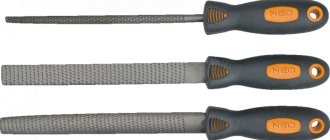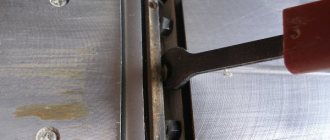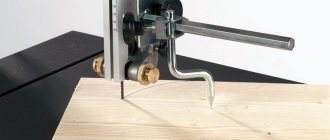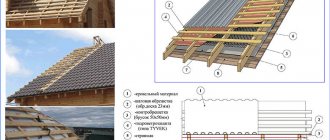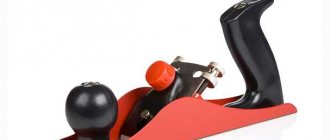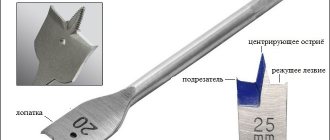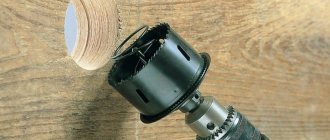The most famous carpenter, Papa Carlo, used to say that working with wood does not tolerate fuss and haste. It is for the soul and should bring peace.
A correctly selected hand plane helps with this - a carpentry tool that is used for planing wood. Its purpose is to give the surfaces of wooden elements the desired shape, eliminate roughness, chamfer and adjust parts to size.
The history of the hand plane goes back to ancient times, and primitive variations of it were discovered during excavations in the city of Pompeii.
What is and what does a plane look like?
A plane is a very simple tool, consisting of a flat sole with a sharply sharpened knife and a block with two handles. During operation, the device is passed over a securely fixed wooden workpiece and neat layers are removed from it. The main grip falls on the front handle, while the rear handle helps make pushing movements more comfortable.
The block of a hand plane can be not only metal, but also wooden
What is a wood plane used for and how does it work?
The planer is designed to give the wood the required shape and thickness. Using the tool, you can remove excess layers from the workpiece and cut carpentry joints in it.
Structurally, the manual device consists of the following parts:
- pads with soles;
- two handles - front and rear;
- clamp with screw;
- steel knife.
When using the plane, the blade extends through a through slot in the sole. The sharpening angle of the knife depends on the specific material to be processed.
Advice! When choosing a hand plane, it is especially important to evaluate how smooth its sole is. If the tool is even slightly bent, it will not be possible to achieve the desired results with it.
How a manual and electric plane works
The operation of the manual device is very simple. A knife is installed on the product, positioned parallel to the sole, and secured with a screw or cam clamp. The tool is placed on the surface of the workpiece and pulled forward with force. The pressure should be placed first on the front of the device, and then on the back. Planing is carried out parallel to the wood fibers - this allows you to get even chips without unnecessary effort.
The purpose and design of an electric planer are almost the same. The difference is that the tool is equipped with a motor and runs on mains power. When turned on, the motor transmits rotation to the drum with knives, which protrudes through the sole. The blades, in motion, cut chips of the required thickness from the wood workpiece without forming depressions or grooves on the surface.
Types of hand planes for wood and their names
The plane is one of the main carpentry tools and comes in many models. Simple devices are intended for rough work, others are used in finishing. Before choosing a tool, you need to study the types of wood planes and their names.
Single
The single hand plane is a simple design with a straight blade. The edge of the knife is slightly rounded, so when processing a workpiece, no grooves are formed on the surface of the workpiece. The device is used mainly for planing wood after cutting or using an ax.
A single plane helps remove rough edges, humps and other irregularities in wood.
Double
The design of the double plane is almost identical to the single one. But its distinctive feature is an additional knife for breaking chips during the planing process. The tool is used in finishing workpieces; with its help, you can achieve good smoothness of the wood and minimize the subsequent use of sandpaper.
A double plane can be used to clean the ends of workpieces from burrs and other irregularities.
Sherhebel
This type of device is equipped with rounded blades set at an angle of 45 degrees relative to the side of the sole. It has a wide clearance for chip removal, suitable for fast rough processing of wood. It does not provide a perfectly smooth surface, but it allows you to plan workpieces not only along the grain, but also across it.
After using Sherhebel, the wood is additionally sanded to remove nicks and rough spots.
Jointer
The jointer has an elongated block and is especially effective at removing protruding parts of the workpiece. Used for treating large surfaces. The cutting edge of the tool does not touch the recesses when moving, so it can be used for finishing grinding.
The effectiveness of a jointer directly depends on its length; the longer it is, the better.
Zinubel
A plane of this type is equipped with a single knife, the blade of which, on the side opposite the chamfer, is covered with small notches that form teeth. During the planing process, the moving edge of the tool creates grooves on the surface of the wood.
Tsinubel is used for rough processing of workpieces before finishing cleaning. The tool also helps prepare hardwood elements for gluing, since grooved surfaces adhere much better to each other.
Most often, tzinubel is used together with other types of planes.
Types of electric planes
An electric plane is a universal tool that is in demand in roughing and finishing wood. Depending on the number of attachments, it can be used to perform rough planing of workpieces or grinding. It is customary to distinguish two types of devices based on power.
Domestic
Tools with a power of 500-1500 W are intended for home use and use in private workshops. They help to quickly cope with planing work in the countryside, are lightweight, have a comfortable grip and are low in cost.
Using a budget electric plane at home is much more practical than using a hand tool. However, such devices are not intended for long-term continuous use.
A household electric planer works well on soft wood
Professional
The professional category includes instruments with a power of 1000-2200 W. Such electric planes are used in furniture production, in the manufacture of window frames and doors.
Premium motorized tools support wide planing depth settings, ensure good wood smoothness after a pass, and cover a large area. The disadvantages of the models include high cost and large weight. Long-term use of the tool tires your hands.
Electric professional planes are equipped with precise adjustment and additional attachments
Notes[ | ]
| Wiktionary has an entry for " plane " |
- Media files on Wikimedia Commons
- ↑ 1 2
Etymology of the word plane (Russian).
ΛΓΩ
. Date accessed: August 21, 2022. - Great Soviet Encyclopedia / Ch. ed. B. A. Vvedensky. - 2nd. - 1955. - T. T. 37. Rona - Samoilovich. — 668 pp., illus. and maps; 59 l. ill. and cards. With.
- Kulebakin, 1992, p. 37.
- Leontiev, 1939, p. 80-81.
- ↑ 12
Leontiev, 1939, p. 80. - Emphasis on: Dictionary of Foreign Words / ed. I. V. Lyokhina and prof. F. N. Petrova. — 4th, revised. and additional.. - M.: State Publishing House of Foreign and National Dictionaries, 1954. - P. 150. - 856 p. — 750,000 copies.
- Galtel // Higher - Geylinx. - M.: Soviet Encyclopedia, 1929. - Stb. 419. - (Great Soviet Encyclopedia: [in 66 volumes] / chief editor O. Yu. Shmidt; 1926-1947, vol. 14).
- Leontiev, 1939, p. 87.
- ↑ 1234
Leontiev, 1939, p. 83. - Kuksov V. A.
Carpentry. - M.: Trudrezervizdat, 1958. - P. 128. - Leontiev, 1939, p. 84-85.
- Leontiev, 1939, p. 82.
- Leontiev, 1939, p. 86.
- Leontiev, 1939, p. 81.
- Kraut F. and Meyer Fr.
Carpentry and joinery work for interior decoration of buildings. - Trutovsky A. E.
A manual for the master of carpentry and furniture production: Goslesbumizdat, 1959. - Leontiev, 1939, p. 85.
- Antonov L.P., Muravyov E.M.
Processing of structural materials: Workshop in educational workshops. - M.: Education, 1982. - P. 81. - 431 p., ill. — 39,000 copies.
How to use an electric planer on wood
The design and principle of operation of an electric planer are quite simple. Before using the tool, you should read the instructions and pay attention to preparing the device for use.
Setting up the plane before work
An electric plane is more complex than a manual one. Even minor malfunctions of the device or minor defects can lead to tool breakage, damage to the workpiece, or injury to the operator. Before using the device you must:
- Carefully inspect the tool and make sure that there is no physical damage to the body and knives.
- Check the movement of the mechanisms and make sure they are not clogged.
- Securely fix the cutting elements of the device.
- Place the wooden piece motionlessly on the work surface.
- Turn the plane over, rotate the drum and secure the knife in the upper position.
- Use a straight edge to ensure that the front plate and sole are parallel.
If measurements show that the elements of the device are not fixed relative to each other unevenly, adjustments need to be made. To do this, remove the handle with the front sole from the body and remove dirt in the internal compartment of the plane. Then the mechanisms are lubricated, the device is reassembled and the position of the elements is checked again.
Adjusting the cutting edge
The instructions for using the electric planer recommend that you adjust the position of its knives before using the tool. You can usually change the planing depth in an electric device using a special switch on the body. It is set to the desired position depending on the type of workpiece and it is checked that the knives are in a position parallel to the plate.
If the blades deviate slightly from the plane, they need to be adjusted. Usually, this is done by unscrewing the fastening bolts, using eccentrics to adjust the blades in height, fixing them again and checking them.
The minimum planing depth is set for hardwood
Attention! If the electric planer is equipped with several cutting elements at once, each of them must be installed in the same position.
Planing with an electric planer
After checking the electric planer and setting it up, you can proceed directly to operation. First of all, you should choose a comfortable working position:
- Stationary. In this way, the plane is used for planing short workpieces. The tool is securely fixed to the work surface, and then the wooden part is moved along its sole.
- Mobile. The board is fixed on a workbench, after which they begin to move an electric tool manually along its surface. This position is considered optimal for processing long workpieces.
It is necessary to move the device along the surface of the board smoothly, in the direction of the grain of the wood. The same force must be applied on all sections of the workpiece; chips and dust should not fall under the moving plate. If the wood is hard, then it is better to plan it in several stages, removing layer by layer with a small depth. This will help achieve perfect smoothness and uniformity during processing.
When working with a plane, you must avoid jerking and uneven pressing, which leaves defects and roughness.
Purpose of the tool
An electric plane is a tool whose main purpose is to level wood surfaces after initial rough processing . As a result, the lumber becomes smooth, various defects are eliminated from its surface, as well as existing irregularities.
Electric planers were first released in 1958. They were intended to replace hand planes.
Today, electric planers are supplied by a number of domestic and foreign manufacturers. Products from the following companies are in demand among consumers:
- Makita;
- Bosch;
- Rib;
- Skil;
- Interskol;
- DeWalt;
- Mafell;
- Hitachi.
For everyday use, they also purchase power tools from Hammer, Fiolent, Energomash, and Baikal. In addition to popular manufacturing companies, electric planers are also supplied to the market by other companies, for example, Diold. But such products are much less common.
Scope of use and functionality
What else you can use electric planers for, besides planing, depends on their technical characteristics and additional capabilities. If the design features of the existing power tool model allow, then you can perform the following operations:
- chamfer trimming;
- creating grooves in workpieces;
- processing lumber and adjusting it to the required size;
- quarter sample;
- obtaining protrusions on the edges of beams or boards (tongues) intended for connecting them together.
That's not all why you need an electric plane. Its capabilities are not limited to this list of work operations. But they are in demand only among specialists: most home craftsmen use the devices mainly only for planing boards or beams.
When planing wooden surfaces using an electric planer, it is possible to control the depth of the cut. This is achieved by adjusting the position of the sole (its front part) in height (diagonally and vertically) using a special handle or button with divisions. In this case, an accuracy of cutting depth when planing up to 1/10 of a millimeter is achieved.
Another useful function of an electric planer is the ability to cut out a fold or a quarter. The operation is performed using an angle stop (ruler), which maintains a constant angle of 90 degrees between the power tool and the beam or board being processed. This also limits the planing area. Fixing the depth limiter on the right side of the equipment allows you to process lumber without cutting out excess wood.
When straight knives are used in the work, the result is not completely satisfactory: slight waviness remains on the treated wooden surface. The use of “spiral” cutting attachments for processing eliminates this disadvantage.
Finishing of boards, beams and other wooden materials is often performed with a plane designed for grinding. In such a tool, the knives have a small, precise stroke, which ensures high-quality results. This eliminates the need to separately sand wooden surfaces.
The presence of a lock button provides protection against accidental switching on of the equipment. Also, the operation of the device is made safer by the possibility of a soft start.
The use of different knives, as well as special devices, expands the basic functionality of an electric planer. The presence of a pipe makes it possible to connect a bag or vacuum cleaner, which allows you to remove chips and dust from the treated area. This facilitates quick garbage collection.
How to use a hand plane on wood correctly
The rules for using hand tools in general are almost the same as the operating instructions for an electric planer. Before work, the device is carefully inspected for defects and it is made sure that the sole is not deformed, and the cutting parts are located parallel to it.
The process of using a plane looks like this:
- A piece of wood is secured in a workbench clamp and a hand tool is placed on top of it.
- The device is firmly grasped by both handles and begins to move smoothly and with even pressure along the fixed board.
- The body is moved forward along with the tool, with the supporting leg placed forward.
As with an electric planer, when performing complex work, it is recommended to remove layers of wood gradually. This will prevent gross mistakes and protect against the appearance of snags, humps and depressions on the surface of the board.
A hand plane is convenient for planing small narrow boards in small quantities.
Additional parameters
- Soft start allows you to gradually apply the load from the engine to the drum. Thanks to this, you can calmly take the equipment in your hand, stand over the product and accurately move the ski to the beginning of the area being treated by pressing the button.
- The kit may include a small frame that holds the electric planer upside down. This is practical for processing narrow beams. After all, the master holds them in his hands, and the plane is used as desktop equipment.
- Some tools include a parallel stop to help control alignment. This is not important in simple surface treatment for table tops or doors, but in the case of removing a layer from only one edge of the timber for decorative processing or selecting a quarter, this is very important.
Rules and safety precautions when working with a plane
Both hand and electric tools are classified as hazardous and require careful handling. In the process, you need to follow basic safety precautions when working with a plane. Namely:
- do not be distracted by extraneous matters;
- check and adjust the instrument before each use;
- when adjusting the cutting parts, position the plane with the knives away from you;
- hold the tool firmly and prevent it from falling;
- Do not push out chips with your hands while working to avoid injury.
When using an electric planer, you need to remember additional rules. In particular, it is prohibited:
- turn on the tool near flammable objects;
- allow the power cord to come into contact with sharp edges and heated surfaces;
- spill water on the instrument;
- touch the rotating drum with your hands.
An electric or manual plane can only be used on dry wood. Wet workpieces cannot be planed - a high-quality result will not be achieved. In addition, when using a tool operating from the mains, there is a risk of receiving an electric shock.
Attention! When working with an electric planer, it is not advisable to use adapters. But if an extension cord is necessary, then it must be selected in accordance with the power of the tool.
What does a plane consist of?
- Let's look at the main components of a carpentry tool called a plane.
- The hole from which wood shavings come out during work, as well as the place from which the cutter protrudes, is called the taphole.
- The cutting piece or blade through which wood is removed is called a cutter.
- The cutter is pressed against the plane body using a clamp or wedge.
- Adjustment knob to adjust cutter extension size.
- The handle located at the front of the plane is called the horn.
- A device that twists and/or breaks chips is called a chip breaker.
- A special regulator ensures even cutting along the width of the plane.
- The back handle of the plane is called the stop.
- The inclination of the cutter is adjusted with a special plate; for adjustment you need to use a screwdriver. The plate is called a frog plane.

